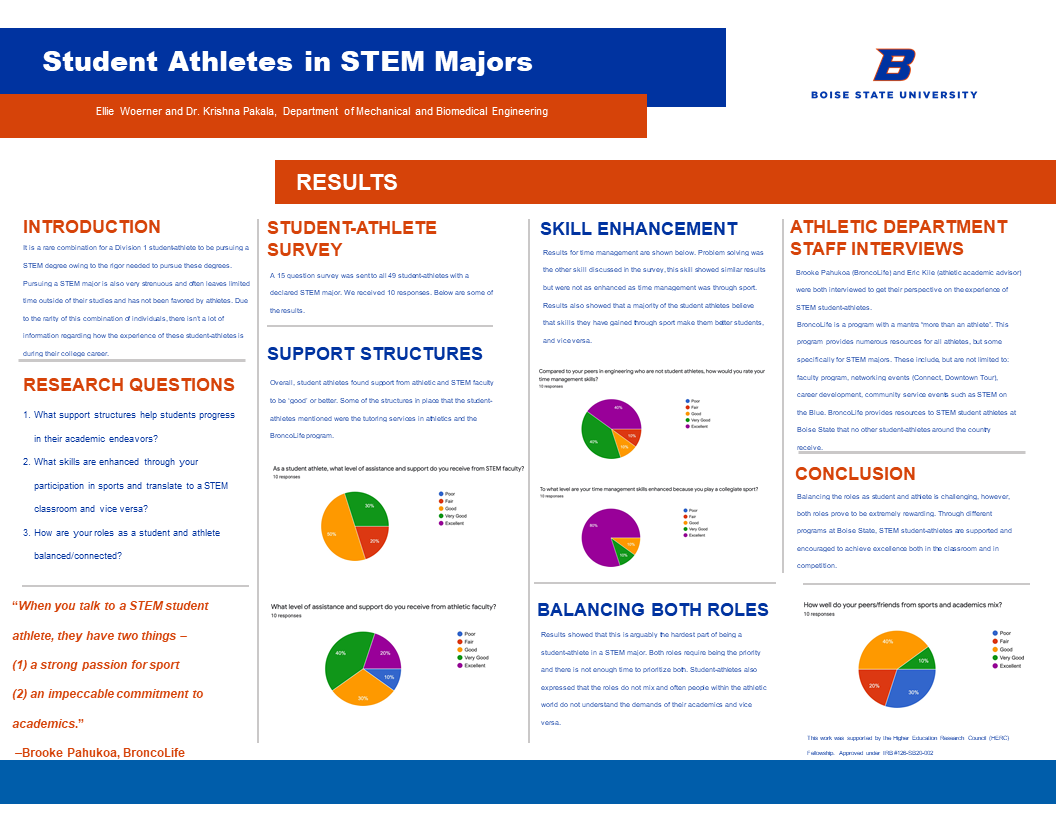Ellie Woerner and Dr. Krishna Pakala, Department of Mechanical and Biomedical Engineering

Introduction
It is a rare combination for a Division 1 student-athlete to be pursuing a STEM degree owing to the rigor needed to pursue these degrees. Pursuing a STEM major is also very strenuous and often leaves limited time outside of their studies and has not been favored by athletes. Due to the rarity of this combination of individuals, there isn’t a lot of information regarding how the experience of these student-athletes is during their college career.
Research Questions
- What support structures help students progress in their academic endeavors?
- What skills are enhanced through your participation in sports and translate to a STEM
classroom and vice versa? - How are your roles as a student and athlete balanced/connected?
“When you talk to a STEM student athlete, they have two things – (1) a strong passion for sport (2) an impeccable commitment to academics” – Brooke Pahukoa, BroncoLife
Student-Athlete Survey
A 15 question survey was sent to all 49 student-athletes with a declared STEM major. We received 10 responses. Below are some of the results.
Support Structures
Overall, student athletes found support from athletic and STEM faculty to be ‘good’ or better. Some of the structures in place that the student athletes mentioned were the tutoring services in athletics and the BroncoLife program.


Skill Enhancement
Results for time management are shown below. Problem solving was the other skill discussed in the survey, this skill showed similar results but were not as enhanced as time management was through sport. Results also showed that a majority of the student athletes believe that skills they have gained through sport make them better students, and vice versa.


Balancing Both Roles
Results showed that this is arguably the hardest part of being a student-athlete in a STEM major. Both roles require being the priority and there is not enough time to prioritize both. Student-athletes also expressed that the roles do not mix and often people within the athletic world do not understand the demands of their academics and vice versa.

Athletic Department Staff Interviews
Brooke Pahukoa (BroncoLife) and Eric Kile (athletic academic advisor) were both interviewed to get their perspective on the experience of STEM student-athletes.
BroncoLife is a program with a mantra “more than an athlete”. This program provides numerous resources for all athletes, but some specifically for STEM majors. These include, but are not limited to: faculty program, networking events (Connect, Downtown Tour), career development, community service events such as STEM on the Blue. BroncoLife provides resources to STEM student athletes at Boise State that no other student-athletes around the country receive.
Conclusion
Balancing the roles as student and athlete is challenging, however, both roles prove to be extremely rewarding. Through different programs at Boise State, STEM student-athletes are supported and encouraged to achieve excellence both in the classroom and in competition.
This work was supported by the Higher Education Research Council (HERC) Fellowship. Approved under IRB #126-SB20-002
Additional Information
For questions or comments about this research, contact Ellie Woerner at elliewoerner@u.boisestate.edu.